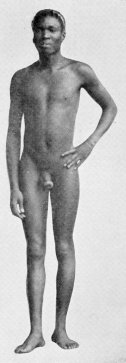|
Body height, or stature, is an important typological characteristic. The shortest individuals of the tallest populations on Earth are still taller than the tallest individuals in very short populations. On this site, seven categories are used. They range from very short, short, rather short, medium height, rather tall, tall, to very tall. Height varies more than other traits within a population, and traditionally short anthropological types may contain relatively tall individuals and vice versa. Significant height differences exist within the same ancestral groups. In addition, nutrition can alter height. Malnutrition causes individuals to remain below their genetic potential, as well as a monotonous diet in some agricultural societies, e.g. in Europe prior to industrialisation. On the other hand, a healthy hunter-gatherer diet
may produce taller individuals. The tallest statures are reached with modern, sugar-rich, calorie-rich diets, despite their negative side effects like obesity and diabetes. The table below shows the typical height variation of the seven categories used for males and females in pre-industrial and post-industrial societies. The first number shows the 10th percentile, e.g. the tallest person of the shortest 10 percent. The second number shows the 90th percentile, e.g. the shortest person of the tallest 10 percent. Thus, the illustrated height ranges encompass 80 percent of the population of the respective height category.
Disease may alter height so that individuals become much taller or shorter than they would naturally. The same occurs in particular conditions like castration. Africa has the greatest height variation of all continents. The picture examples below all show Sub-Saharan Africans. The maps show regions where a stature is common in native populations. On an individual level, different heights may regularly appear in the black areas, too.
|













